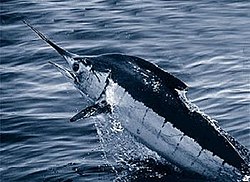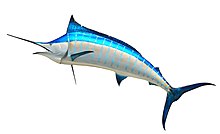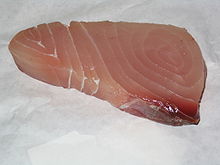Atlantic blue marlin
| Atlantic blue marlin | |
|---|---|
 | |
| Conservation status | |
| Scientific classification | |
| Kingdom: | Animalia |
| Phylum: | Chordata |
| Class: | Actinopterygii |
| Order: | Perciformes |
| Family: | Istiophoridae |
| Genus: | Makaira |
| Species: | M. nigricans |
| Binomial name | |
| Makaira nigricans Lacépède, 1802 | |
 | |
| The range of the Atlantic blue marlin | |
Marlin are distributed throughout the Atlantic's tropical and temperate waters; they are more populous in the western parts. It is a blue water fish that spends the majority of its life in the open sea, far away from land.[2] Females can grow up to four times the weight of males. The maximum published weight is 820 kilograms (1,800 lb).[3] Marlin have few predators apart from man; the IUCN currently consider it a threatened species due to overfishing.[1]
Some other historic English names for the Atlantic blue marlin are the Cuban black marlin, ocean gar, and ocean guard.[4]
Taxonomy and naming
The Atlantic blue marlin is one of three species in the genus Makaira. This name is derived from the Greek word machaira, meaning "a short sword or bent dagger", and the Latin machaera, "sword".[5][6] The specific epithet nigricans is Latin for "becoming black".[7] The Atlantic blue marlin is part of the billfish family Istiophoridae and is in the perch-like order Perciformes. In addition, it is in the suborder Xiphioidei and is a member of the subclass Neopterygii, which means "new wings". It is also in the class of Actinopterygii, which includes ray-finned fishes and spiny rayed fishes, and the superclass Osteichthyes, which includes all of the bony fishes.[8][9]The Atlantic blue marlin was first described in 1802 by Bernard Germain de Lacépède. Some other names that have been used in the past are Histiophorus herschelii (Gray, 1838), Tetrapturus herschelii (Gray, 1838), Makaira ampla ampla (Poey, 1860), Tetrapturus amplus (Poey, 1860), Orthocraeros bermudae (Mowbray, 1931), and Makaira perezi (Buen, 1950).[4]
Makaira mazara
The status of the Indo-Pacific blue marlin (Makaira mazara) as a separate species is under debate. Genetic data suggests that, although the two groups are isolated from each other, they are both the same species.[10] A separate study by V. P. Buonaccorsi, J. R. Mcdowell, and Graves indicated that both Indo-Pacific and Atlantic show "striking phylogeographic partitioning" of mitochondrial and microsatellite loci.[11] This study presented both populations as members of one species, with the only genetic exchange occurring when Indo-Pacific blue marlin migrate to and contribute genes to the Atlantic population.Physical description

Intact fish skeleton at the North Carolina Museum of Natural Sciences
This marlin has two dorsal fins and two anal fins. The fins are supported by bony spines known as rays. Its first dorsal fin has 39 to 43 rays from front to back.[15] Its second dorsal fin has 6 to 7 rays.[15] Its first anal fin, which is similar in shape and size to the second dorsal fin, has 13 to 16 rays,[15] and the second anal fin has 6 to 7 rays.[15] The pectoral fins, which have 19 to 22 rays,[15] are long and narrow and can be drawn in to the sides of the body. The pelvic fins are shorter than the pectorals, have a poorly developed membrane, and are depressible into ventral grooves. Its first anal fin, along with its pectoral and caudal fins, can be folded into grooves. This streamlines the fish and thereby reduces drag.
The body is blue-black on top with a silvery white underside. It has about fifteen rows of pale, cobalt-colored stripes, each of which has round dots and/or thin bars, located on both sides of the fish.[15] The first dorsal fin membrane is dark blue or almost black and has no dots or marks. Other fins are normally brownish-black, sometimes with a hint of dark blue. The bases of the first and second anal fins have a hint of silvery white. Marlin can rapidly change color and usually appear bright blue when hunting. The coloration results from pigment-containing iridophores and light-reflecting cells.[16] The body is covered with thick, bony, elongated scales that have one, two, or three posterior points, with one being the most common form.[15]
The bill is long and stout. Both the jaws and the palatines (the roof of the mouth) are covered with small, file-like teeth. The lateral line system is a group of neuromasts rooted in lateral line canals that can sense weak water motions and large changes in pressure.[17] It has the appearance of a net.[18] It is obvious in immature specimens but unclear in adults, becoming progressively embedded in the skin.[15] The anus is just in front of the origin of the first anal fin.
Range and migration
The Atlantic blue marlin is the most tropical of the billfishes. Its latitudinal range changes seasonally and extends from about latitude 45°N to about latitude 35°S. It is less abundant in the eastern Atlantic where it mostly occurs off Africa between the latitudes of 25°N and 25°S. The marlin usually inhabits waters warmer than 24 °C (75 °F) but has been found at surface water temperatures as high as 30.5 °C (86.9 °F) and as low as 21.7 °C (71.1 °F).[19] Water color is also important, as marlin prefer blue water.[15]Its range expands northward during the warmer months and contracts towards the equator during colder months.[20]
Marlin can undertake long migrations, including repeatedly between the Caribbean Islands and Venezuela and the Bahamas, as well as between the Caribbean Saint Thomas, U.S. Virgin Islands and West Africa. It is unknown if the trans-Atlantic fish ever return to the western Atlantic, despite an extensive tagging project in the eastern Atlantic. Several fish were later recaptured in the same general area where they were tagged, implying reverse migration after/over several years, but there is insufficient data to accurately determine seasonality.[21]
[edit] Predators and parasites
The great white shark and shortfin mako are predators of the Atlantic blue marlin.[22]Blue marlins have many parasites. They include parasites from the following groups; digenea (flukes), didymozoidea (tissue flukes), monogenea (gillworms), cestoda (tapeworms), nematoda (roundworms), acanthocephala (spiny-headed worms), copepods, barnacles, and cookiecutter sharks.
Remoras are commonly found attached to Blue marlins, often inside the opercula.
Life cycle
Growth and maturityDiet and feeding
The larvae feed upon a variety of zooplankton along with drifting fish eggs and other larvae. They progress to feeding on a wide range of fishes, particularly scombrids such as mackerel and tuna; squid; and also, especially near oceanic islands and coral reefs, on juvenile inshore fish. Studies of stomach contents in both the Atlantic and Pacific have found that smaller schooling scombrids such as frigate mackerel, bullet tuna, and skipjack tuna make up a substantial proportion of their diet. Squid, including the large Humboldt squid, and deep-sea fishes such as pomfret and snake mackerel, are also important prey items in certain areas. Blue marlin have been recorded to take prey as large as white marlin, as well as yellowfin and bigeye tuna in the 100 pounds (45 kg) range. Conversely, they are also capable of feeding on small but numerous prey such as filefish and snipefish.
Scientists and fishermen have long debated the extent to which blue marlin and other billfish use their elongated upper jaw in feeding. A 2007 Japanese study of stomach contents of fish captured in a commercial trolling fishery found that 130 undigested prey items obtained from 227 blue marlin had spearing, slashing and other injuries that were judged to have been inflicted by the bill.[24]
Economic importance
Marlin are often caught as bycatch in tuna longline fisheries. Marlin has commercial value throughout the world, with landings totalling 3,064 metric tons in 2000.[12] Their meat has a high fat content. It is particularly valued in Japan for sashimi.[12] In Hawaii, blue marlin meat is commonly smoked and sold by roadside vendors.Because of their relative rarity, beauty, and sporting qualities, marlin are considered one of the most prestigious catches a recreational fisherman can make. The IGFA (International Game Fish Association) all-tackle world record is 1,402 pounds 2 ounces (636 kg).[4] The sportfishing pursuit of marlin and other billfish is a multi-million dollar industry that includes hundreds of companies and thousands of jobs for boat operators, boat builders, marinas, dealerships, and fishing tackle manufacturers and dealers. The most established marlin fisheries are found along the eastern seaboard and the Gulf Coast of the United States, the Bahamas and several other Caribbean islands (notably St Thomas and Puerto Rico), Venezuela, Brazil, and Bermuda.[12]
Conservation
The Atlantic blue marlin is under intense pressure from longline fishing. In the Caribbean region alone, Japanese and Cuban fishermen annually take over a thousand tons. All vessels within 200 miles (320 km) of the U.S. coastline are required to release any billfish caught. However, the survival rate of released fish is low because of damage during capture.[4]The Atlantic blue marlin is listed as a threatened species by the International Union for Conservation of Nature (IUCN).[1] In 2010, Greenpeace International added the Atlantic blue marlin to its seafood red list. "The Greenpeace International seafood red list is a list of fish that are commonly sold in supermarkets around the world, and which have a very high risk of being sourced from unsustainable fisheries. The World Conservation Union does not currently consider it a threatened species."[25]
In popular culture
In Ernest Hemingway's novella The Old Man and the Sea a fisherman named Santiago battles an Atlantic blue marlin for three days off the coast of Cuba.[2][26]The blue marlin is in the NDS game Animal Crossing: Wild World and Wii game Animal Crossing: City Folk.




No comments:
Post a Comment